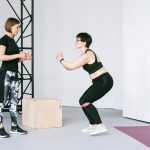So, have you ever wondered what exactly yoga pants are made of?
Well, let me tell you, when I recently picked up a pair of my favorite yoga leggings, I couldn't help but notice how comfortable and stretchy they were.
But what materials were used to make them so perfect for my yoga sessions?
The answer lies in the blend of fabrics carefully selected to enhance performance and fit.
Let's dive into the world of yoga pant materials and uncover the secrets behind their popularity and functionality.
Table of Contents
Key Takeaways
- Yoga pants are made of natural fabrics like cotton and bamboo, or synthetic materials such as polyester and nylon.
- Synthetic fibers like spandex provide stretch and flexibility for comfort during yoga sessions.
- Moisture-wicking properties in fabrics like polyester and nylon keep you cool and dry during workouts.
- Sustainable options like organic cotton and bamboo offer eco-conscious choices for activewear.
Natural Fabrics
When it comes to yoga pants, choosing natural fabrics like cotton, bamboo, or organic cotton can truly enhance your practice. These fabrics offer eco-friendly and sustainable qualities that not only benefit the environment but also elevate your overall yoga experience.
Cotton, a popular choice for yoga pants, is loved for its softness and ability to absorb moisture, keeping you dry and comfortable during your practice. The breathable nature of cotton makes it a fantastic option for those seeking comfort and ease of movement during yoga sessions.
Bamboo fabric, another excellent choice for yoga pants, isn't only sustainable and biodegradable but also naturally antibacterial. This makes it an ideal option for individuals who are environmentally conscious and prioritize hygiene during their workouts.
Organic cotton yoga pants take it a step further by being free from synthetic chemicals, providing a natural and eco-friendly alternative for yoga enthusiasts looking to align their values with their practice. The use of these natural fabrics in yoga pants not only feels great on the skin but also supports a healthier planet.
Synthetic Materials
I'm excited to touch on the synthetic materials used in yoga pants. These fabrics, like polyester and nylon, offer durability, stretchiness, and excellent moisture-wicking abilities, keeping you comfortable during your practice.
Understanding the fabric composition, durability, and moisture-wicking properties can help you choose the perfect yoga pants for your active lifestyle.
Fabric Composition
Synthetic materials like polyester, nylon, and spandex form the foundation of yoga pants, offering essential stretch, durability, and moisture-wicking capabilities for optimal performance during physical activities.
- Stretch Fabric: The blend of synthetic fibers in yoga pants allows for unparalleled stretch and flexibility, ensuring comfort and freedom of movement.
- Synthetic Fibers: Derived from oil and gas, materials like polyester and nylon are commonly used in crafting yoga pants for their durability and performance-enhancing properties.
- Moisture-Wicking Fabric: Synthetic fabrics like spandex and Lycra excel in wicking away moisture, keeping you dry and comfortable during intense workouts.
These synthetic fabrics are carefully chosen to provide the ideal combination of features necessary for a superior yoga experience.
Durability and Stretch
The durability and stretch provided by synthetic materials like polyester, nylon, and spandex are essential components of high-quality yoga pants, ensuring long-lasting performance and flexibility for active individuals. These materials, such as Lycra spandex, offer excellent stretch properties, allowing for a full range of motion during yoga practice and other physical activities. Polyester, known for its durability, ensures that yoga pants maintain their shape even after multiple washes, making them ideal for long-term use. Spandex, or Lycra, adds elasticity to the fabric, providing a comfortable and secure fit that adapts to different body shapes. This combination of durability and stretch in synthetic fibers makes yoga pants a reliable choice for those seeking both quality and performance.
| Durability | Stretch | Material |
|---|---|---|
| Excellent | Flexibility | Polyester |
| Long-lasting | Range of motion | Nylon |
| Resilient | Elasticity | Spandex |
Moisture-Wicking Properties
How can yoga pants crafted from synthetic materials like polyester, nylon, and spandex enhance your workout experience through their innovative moisture-wicking properties?
Synthetic materials in yoga pants offer exceptional benefits for your workout routine:
- Moisture-Wicking: Fabrics draw sweat away from the body, keeping you dry and comfortable.
- Breathability: Synthetic materials promote airflow, preventing moisture build-up and enhancing comfort.
- Quick Drying: The moisture-wicking technology ensures a dry and cool feel, ideal for intense yoga sessions.
These properties make synthetic materials a preferred choice for activewear, reducing the risk of chafing and irritation while providing the necessary support and comfort needed during physical activities.
Blends
Blended materials are essential components of yoga pants, combining synthetic fibers like nylon, polyester, and spandex to enhance comfort and performance. These blends offer a perfect balance of stretch, durability, and moisture-wicking properties, making them ideal for various activities. The use of synthetic fibers ensures that the yoga pants retain their shape over time, providing lasting comfort and support.
Nylon and polyester are favored for their durability, with spandex adding the necessary flexibility for ease of movement. The combination of these materials results in yoga pants that aren't only comfortable but also highly functional. The popularity of these blends in the activewear market speaks to their effectiveness in meeting the demands of both casual wear and intense workouts.
Performance Enhancing Technologies
Let's talk about the incredible technologies that make yoga pants not just comfortable but performance-enhancing.
From innovative fabric blends to moisture-wicking properties, these pants are designed to keep you dry and comfortable even during the toughest workouts.
Features like compression panels, seamless designs, and gusseted crotches work together to support your body, enhance flexibility, and provide a range of motion that allows you to flow through your yoga practice effortlessly.
Fabric Technology Overview
Synthetic fabrics such as polyester, nylon, and spandex form the foundation of yoga pants, incorporating performance-enhancing technologies like Lycra and moisture-wicking properties to enhance comfort and functionality.
- Advanced moisture-wicking capabilities keep you dry and comfortable during intense workouts.
- Lycra technology provides unparalleled stretch for unrestricted movement in various yoga poses.
- Durable synthetic fibers maintain shape and support, ensuring long-lasting performance for your yoga practice.
Moisture-Wicking Benefits
Utilizing advanced moisture-wicking technology, yoga pants are designed to efficiently draw sweat away from the body, keeping the skin dry and cool during intense workouts. These performance-enhancing fabrics, commonly made of polyester and nylon, excel at evaporating moisture rapidly, preventing discomfort and chafing.
The moisture-wicking properties play a crucial role in temperature regulation, enhancing overall comfort and performance during physical activities. By efficiently managing sweat, yoga pants with moisture-wicking capabilities ensure a more pleasant workout experience.
Whether you're engaging in a vigorous yoga session or hitting the gym for a challenging workout, the moisture-wicking feature in these pants is essential for maintaining dryness and comfort, allowing you to focus on your exercise routine.
Breathable Design Features
Breathable design features in yoga pants incorporate advanced performance-enhancing technologies to optimize ventilation and ensure a comfortable experience during physical activities. These features are essential for active individuals seeking superior functionality in their workout gear.
Here are three key elements that make breathable design features in yoga pants stand out:
- Moisture-wicking properties: Synthetic fabrics like polyester and nylon draw sweat away from the body, keeping you dry and comfortable during intense workouts.
- Enhanced ventilation: Breathable materials allow for better airflow, preventing overheating and regulating body temperature.
- Cooling technologies: Performance-enhancing fabrics support the body's cooling process through evaporation, ensuring you stay comfortable and focused during your yoga sessions or workouts.
Sustainable Options
For eco-conscious yogis seeking sustainable activewear, organic cotton and bamboo materials offer environmentally friendly options for yoga pants. Organic cotton yoga pants contribute to global sustainability efforts by reducing the environmental impact of conventional cotton production. This material is grown without the use of harmful chemicals and pesticides, making it a healthier choice for both the wearer and the planet.
On the other hand, bamboo fabric used in yoga pants isn't only practical and sustainable but also known for its softness and moisture-wicking properties. Choosing yoga pants made from these sustainable materials aligns with eco-conscious practices and supports ethical fashion choices.
Innovations in Fabric Technology
What fabric technologies have revolutionized the design of modern yoga pants?
- Luon: This innovative fabric provides a cottony-soft feel with excellent four-way stretch, making it ideal for both yoga sessions and everyday wear.
- Luxtreme: Offering sweat-wicking properties, four-way stretch, and a cool, smooth feel, Luxtreme fabric is perfect for high-performance activities such as intense workouts.
- Nulux: Designed for lightweight coverage and a sensation akin to being naked, Nulux fabric is the go-to choice for activities like running or hot yoga.
These innovative fabrics have transformed the way we wear yoga pants. With a focus on providing stretch, durability, and comfort, brands like Lululemon have engineered fabrics like Luon, Luxtreme, and Nulux to cater to the needs of active individuals. Whether you're flowing through a yoga class or pushing your limits in a workout, these fabric technologies ensure that your yoga pants move with you, keeping you comfortable and supported throughout your practice.
Frequently Asked Questions
What Are Most Yoga Pants Made Of?
Yoga pants, my go-to for flexibility and comfort, are mainly crafted from synthetic materials like polyester and spandex. These fibers offer stretch and durability, perfect for my active lifestyle. They keep me moving!
What's the Difference Between Yoga Pants and Leggings?
Yoga pants provide performance for active movement during yoga, while leggings offer versatility for everyday wear. The focus of yoga pants is on practicality and performance, fitting well in specific areas, whereas leggings are snug from top to bottom.
Which Fabric Is Best for Yoga?
When practicing yoga, choosing fabrics like nylon, Lycra, or polyester in yoga pants is key for comfort and performance. They offer stretch, durability, and moisture-wicking properties. These materials help me stay dry and flexible during my practice.
Are Yoga Pants Made of Plastic?
Yoga pants are indeed made of plastic, with common materials being polyester, nylon, and spandex. These synthetic fabrics, derived from oil and gas, provide durability and flexibility for comfortable and high-performance activewear.
- A Review of the Theory Gabardine Trench Coat for Modern Minimalists - June 24, 2025
- Fear of God’s Modern Interpretation of the Wool Gabardine Overcoat - June 24, 2025
- The Ultimate Guide to Saint Laurent’s Wool Gabardine Pieces - June 24, 2025





